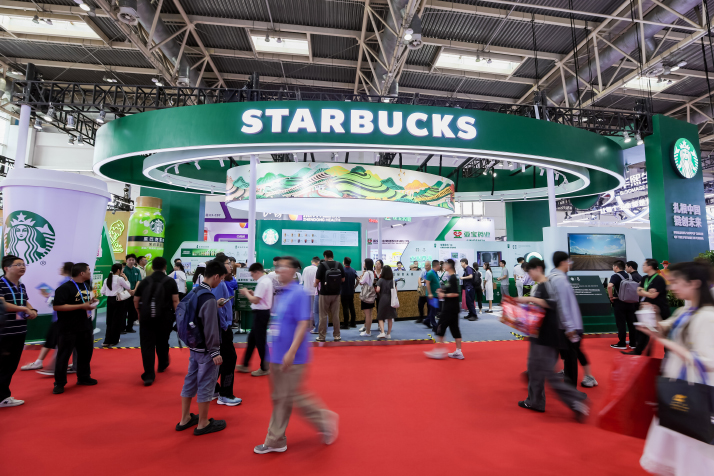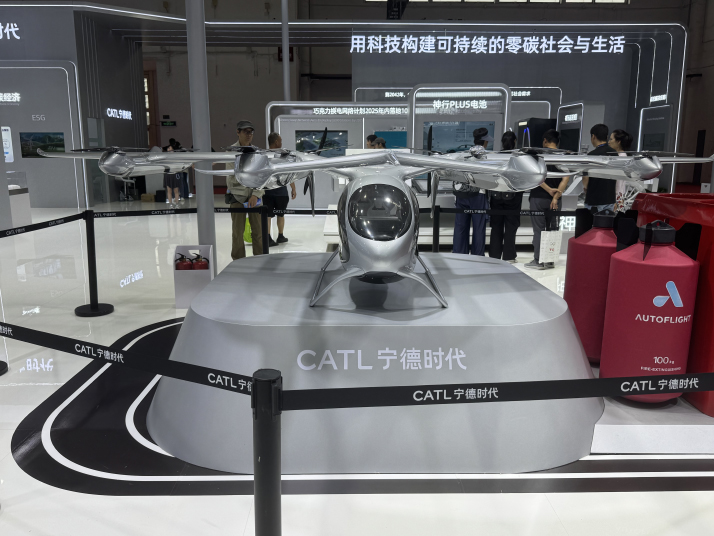| Business |
| The connectivity playbook | |
|
|
 The Starbucks booth at the Third China International Supply Chain Expo (CISCE) in Beijing on July 16 (COURTESY PHOTO)
Amid uncertainties shaking up the global economy, the Third China International Supply Chain Expo (CISCE), held in Beijing on July 16-20, emerged as a platform for strengthening resilient and cooperative global supply chains. The expo, hosted by the China Council for the Promotion of International Trade (CCPIT), brought together 1,200 exhibitors from 75 countries and regions. Total attendance—both online and in person—surpassed 210,000, up 5 percent from last year's edition. Li Xingqian, Vice Chairman of CCPIT, said at the closing ceremony that 152 new products, technologies and services had been launched during the event, up 67 percent year on year. Exhibitors established business ties with over 42,000 up- and downstream enterprises, and more than 6,000 cooperation agreements and partnership intentions were secured. "CISCE is a platform for China to boost international cooperation across industrial and supply chains," he said. Links to China The number of participating U.S. companies and institutions at this year's expo increased by 15 percent compared to the previous edition, remaining the largest group of overseas exhibitors, CCPIT said. Making its debut at the expo, U.S. chipmaker NVIDIA displayed its products ranging from chips to AI solutions. NVIDIA CEO Jensen Huang said at the opening ceremony of the expo that China's commitment to open-source AI is a powerful catalyst for global advancement, enabling nations and sectors everywhere to join the AI revolution. Huang noted earlier that NVIDIA's H20 chips will soon return to the Chinese market, following U.S. Government approval of export licenses for these AI processors. Having participated in CISCE for the third consecutive year, U.S. coffee giant Starbucks has been largely involved in China's specialty coffee industry. It currently operates over 7,700 stores across more than 1,000 cities (counties) in the country. According to the company, approximately 70 percent of its total carbon emissions in China originate from upstream suppliers, including the dairy, logistics and packaging sectors. To reduce operational carbon emissions, Starbucks China announced a strategic partnership with green tech leader Envision Group at this year's expo. Over the next three years, the two sides will work together to develop a digital carbon management platform covering all Starbucks China's direct suppliers, measuring carbon footprints and customizing plans for carbon emissions reduction. French beauty brand L'Oréal made its first appearance at the expo this year. Marc-Antoine Poulle, Senior Vice President of L'Oréal Operations North Asia and China, said the company has been actively expanding its presence in China, delivering beauty products to local consumers while increasing strategic investments. A vital link in the brand's global supply chain, China also serves as an innovation incubator, driving breakthroughs in the beauty industry. L'Oréal now has 32 brands in China, with 62 percent of their products produced in the company's two China factories: one in Suzhou, Jiangsu Province, and one in Yichang, Hubei Province. The company has also launched its first smart operation center in Suzhou. Equipped with intelligent systems, the center can ship 7,000 direct-to-consumer orders per hour. L'Oréal has developed partnerships with over 1,600 Chinese suppliers. Through its global network, many of its Chinese partners have built factories overseas and sold independently developed products to the global market. Over the past years, McDonald's has developed a firm footing in the Chinese market, with over 7,100 outlets nationwide as of this year. At the expo, McDonald's China, along with its 11 supplier partners, showcased their collaboration through "McChain," an initiative for further cooperation on ensuring green production and building smart supply chains. Since 2018, McDonald's China, together with its domestic partners, has invested over 12 billion yuan ($1.7 billion) in new production capacity. In 2024, over 90 percent of its total procurement spending went to domestic suppliers.  An electric vertical take-off and landing (eVTOL) aircraft displayed at the booth of Chinese power battery giant Contemporary Amperex Technology Co. Ltd. at the Third CISCE in Beijing on July 17 (LI XIAOYANG)
Going global The expo has served as a global stage for Chinese enterprises to present their technological breakthroughs, underpinned by the country's complete industrial chains and vast market potential. Power battery giant Contemporary Amperex Technology Co. Ltd. (CATL) showcased its battery products and green solutions at the event. The company has built 10 zero-carbon battery factories across China. Capitalizing on China's booming electric vehicle (EV) market, CATL has created its own battery swap management system and partnered with automakers like Chang'an Auto. "While charging an EV often takes around two hours, CATL's network allows drivers to complete a battery swap in two minutes without exiting their vehicles," Song Xiaoyi, a staff member with the company, told Beijing Review, noting that it aims to deploy 1,000 such stations by the end of this year. CATL has made battery recycling a priority. The company currently operates seven recycling facilities with an annual capacity of 120,000 tons of used batteries across the world—representing 34.4 percent of the world's total battery recycling volume. Alibaba introduced its AI solutions empowering e-commerce at the event. Its 1688.com, a business-to-business online trading platform, covers over 1 million source manufacturers. According to the company, an increasing number of Chinese merchants have leveraged the platform to expand their presence abroad. Overseas cross-border orders on 1688.com surged more than 70 percent year on year in 2024, among which orders from overseas local users increased more than 50 percent from a year earlier, it said. The platform has introduced its Al-powered digital avatars designed for small and medium-sized enterprises. The virtual employees can perceive information and interact through voice, reducing costs and improving efficiency in business operations. Resilient chains "As a manufacturing and trading powerhouse, China has contributed largely to the stability and resilience of the global supply chain," Xu Jiabin, an economics professor at Renmin University of China, told Beijing Review. Geopolitical tensions have disrupted supply chains and affected the interests of all parties involved. Countries now need to jointly improve the global supply chains' connectivity for common benefits, Xu said. Zhou Xing, head of public affairs at leading services firm PwC China, told Xinhua News Agency that global supply chains are shifting from a model focusing solely on efficiency to one that prioritizes resilience, and companies are diversifying their supply networks while maintaining global collaboration. "Through boosting new sectors like EV and biotech, China is strengthening its position in global value chains," Zhou said. China offers a large market, policy certainties and the innovation momentum global businesses are looking for. It will remain attractive for multinational firms looking to restructure their supply chains, she said. BR Copyedited by Elsbeth van Paridon Comments to lixiaoyang@cicgamericas.com |
|
||||||||||||||||||||||||||||||
|